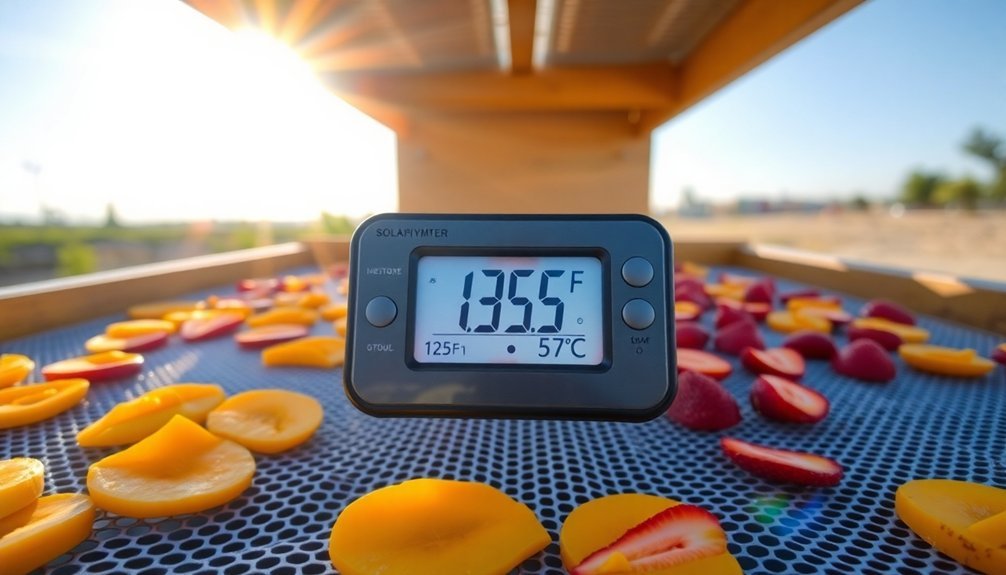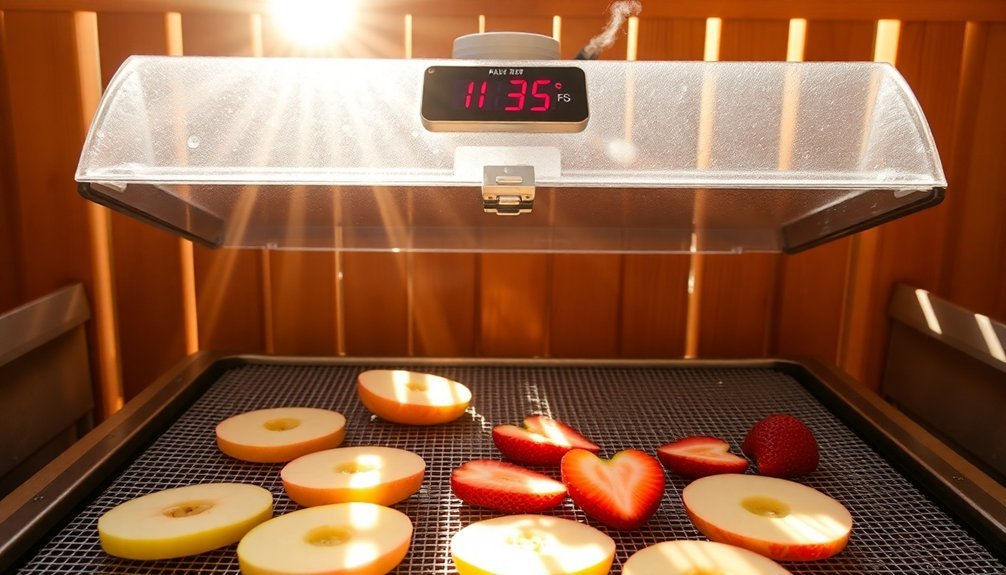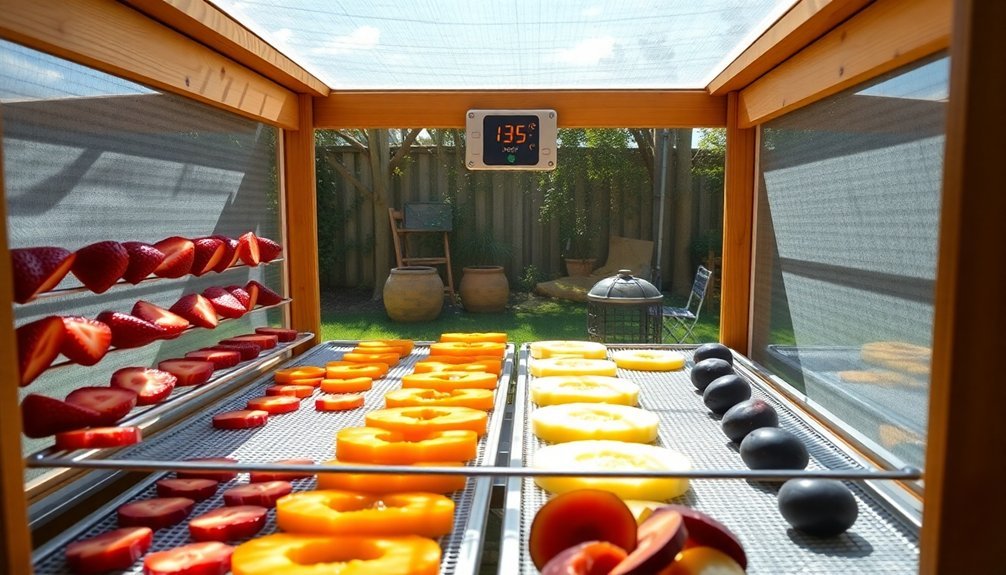For best results, you'll want to maintain your solar dehydrator between 130-140°F (54-60°C) when drying fresh fruit. Different fruits require specific temperatures within this range – delicate berries need 130-135°F, while apples and pears do well at 135°F. Keep your dehydrator facing south and adjust the collector angle to 54° during spring and fall for maximum sun exposure. Monitor the temperature regularly using a thermometer, and guarantee proper air circulation by spacing fruit pieces evenly on the drying trays. With careful attention to temperature control, you'll discover the key factors that transform fresh fruit into perfectly dried treats.
Understanding Solar Dehydrator Temperature Ranges

Setting up a solar dehydrator requires a solid understanding of temperature control. You'll need to maintain temperatures between 100 and 140 degrees Fahrenheit to achieve ideal dehydration results for your fresh fruit. This specific range is significant because temperatures that fall below it can promote bacterial growth, while higher temperatures will cook your fruit instead of dehydrating it.
To monitor your dehydrator's temperature accurately, you'll want to use a thermometer that can measure between 90 and 200° F. This will help you guarantee you're maintaining the right conditions to reduce your fruit's moisture content effectively. Solar dehydrators are an energy-efficient alternative to electric models, helping you save on utility costs. You can adjust the temperature by orienting your dehydrator toward or away from direct sunlight as needed.
You'll find that proper heat trapping is vital for maintaining these temperatures. Use a transparent cover like glass or plastic to let sunlight in while keeping heat inside. This setup works even in cold or windy conditions.
For enhanced temperature control, consider lining the interior with reflective materials like aluminum foil. These materials help retain heat and maintain consistent temperatures throughout the drying process.
Optimal Heat Levels By Fruit
Your solar dehydrator's temperature ranges need careful monitoring, with most fruits drying best at around 140°F (60°C), while delicate berries prefer slightly lower temps of 130-135°F (54-57°C).
You'll want to track your dehydrator's heat levels throughout different seasons, as summer months may require less direct sun exposure to maintain ideal temperatures.
You can adjust for seasonal variations by repositioning your dehydrator or using partial shade during intense heat, ensuring your fruits dry effectively without cooking. Using a hygrometer for testing helps maintain proper moisture levels throughout the drying process.
Temperature Ranges For Success
Maintaining the right temperature is critical when dehydrating fresh fruit in a solar dehydrator. You'll want to keep temperatures between 125-135°F for most fruits, as this range prevents bacterial growth while avoiding accidental cooking of your produce. If temperatures drop below 100°F, you're risking bacterial contamination, while exceeding 140°F can cook your fruit rather than properly dehydrating it.
When you're working with different fruits, you'll find most varieties respond well to the standard temperature range. However, you'll need to monitor berries more carefully, as they might require slightly lower temperatures to maintain their desired texture. Using only high-quality fresh produce will ensure the best possible results in your solar dehydrator.
Be aware that high-moisture fruits like citrus and melons can be particularly challenging to dehydrate effectively.
You'll need to factor in humidity and air circulation when setting your temperatures. If you're in a humid climate, you might need to adjust your settings to compensate for the moisture in the air.
Good airflow is essential – it helps remove moisture and prevents case hardening, where the outer layer dries too quickly while the inside remains moist.
Watch for signs of improper drying, such as texture changes or discoloration, which can indicate your temperature needs adjustment.
Monitoring Heat By Season
Seasonal temperature shifts play a crucial role in solar dehydration success. You'll find spring and fall offer ideal conditions with mild temperatures that won't overcook your fruit. In places like Stillwater, Oklahoma, you'll want to set your solar collector at a 54-degree angle during these seasons to maximize sun exposure.
You'll need to adjust your approach based on both the season and fruit type. When you're working with thin-sliced fruits like tangerines and pears, you can achieve complete dehydration in a single day. However, thicker fruits like papayas and whole berries will require additional time.
During humid seasons, you'll notice slower drying times, so plan accordingly. To maintain optimal conditions, you'll want to protect your fruit from nighttime dew by bringing it indoors or providing adequate shade coverage.
If you're in a tropical region, you'll benefit from abundant sunshine, but watch for excessive heat that could cook rather than dry your fruit. Remember to monitor air circulation constantly, as proper airflow prevents moisture from condensing on your fruit, especially during warmer seasons when humidity can spike.
Season and Temperature Control

You'll need to adapt your solar dehydrator's settings throughout the year to match seasonal temperature shifts, with particular attention to the collector angle and available sun hours.
Your collector angle should be adjusted seasonally, like the 54-degree setting needed for spring and fall in Stillwater, Oklahoma, to maximize sun exposure and heat collection.
During inclement weather or reduced sunlight, you can maintain ideal temperatures between 57°C to 68°C by employing auxiliary heaters or automated fan systems to regulate the internal environment.
Yearly Temperature Patterns
The effectiveness of a solar dehydrator depends heavily on yearly temperature patterns and your ability to control them.
During spring and fall, you'll need to maintain temperatures between 120°F and 140°F, which requires careful monitoring and potentially larger collector areas due to lower solar irradiance. You'll also want to guarantee proper insect screening since drying times are longer in these seasons.
Summer brings its own challenges with temperatures reaching up to 221°F in stagnation conditions. You'll need to check your dehydrator more frequently and implement proper ventilation to prevent overheating. Consider using a small solar-powered fan to improve air circulation and maintain ideal temperatures.
Winter operation requires additional considerations. You'll face reduced solar irradiance, with collector temperatures dropping to around 202°F. You might need to add extra insulation or increase your collector area to maintain necessary temperatures.
Installing automated control systems with thermocouples and relays can help you maintain consistent conditions year-round. Don't forget to use proper monitoring equipment, like thermometers that can measure between 90°F and 200°F, to track your dehydrator's performance throughout the seasons.
Adjusting Collector Angles
Managing year-round temperatures becomes simpler when you understand collector angle adjustments. Your dehydrator's collector angle should typically match your location's latitude, but you'll need to make seasonal adjustments to maintain ideal temperatures between 120-140°F.
During summer months, you'll want to set your collector angle smaller than your latitude to maximize energy collection. This adjustment helps you achieve a solar fraction of unity, though you'll need to monitor temperatures closely as they can exceed your needs. You can fine-tune the temperature by installing vents and ensuring proper airflow.
For winter operations, increase your collector angle by 10° to 20° above your latitude. This adjustment compensates for the sun's lower position and helps maintain adequate solar radiation capture during colder months. You'll find this especially important for maintaining consistent drying temperatures.
To enhance your dehydrator's performance, line the collector box with aluminum foil reflectors and use fiberglass-reinforced polyester glazing. Keep a thermometer inside to monitor temperatures regularly.
With these adjustments, you'll maintain ideal drying conditions regardless of seasonal changes, ensuring your fruit dehydrates effectively year-round.
Weather Impact Strategies
While seasonal changes pose challenges for solar dehydrators, modern temperature control systems assure consistent drying conditions throughout the year. You'll find that Arduino-controlled systems with multiple thermocouples monitor temperatures across different areas, guaranteeing your fruits maintain ideal drying conditions between 135°F (57°C).
When solar energy isn't sufficient, you can rely on auxiliary heaters to maintain steady temperatures between 60-65°C. Your system's programmable LCD display lets you adjust settings based on weather conditions, while the automated feedback loop activates fans and heaters as needed.
You'll notice that proper insulation using rubber sheets helps maintain consistent internal temperatures regardless of external weather fluctuations.
During varying weather conditions, you can count on the desiccant beds to absorb excess moisture and regulate temperature. The system's coordinated fan activation, featuring two sequential fans and a fourth relay fan, assures homogeneous temperature distribution.
You'll also benefit from the automated controls that adjust to seasonal variations, while the flash memory storage helps you track and enhance your dehydration process based on weather patterns and performance data.
Fruit Preparation Guidelines
When arranging your prepared fruit, place pieces in single layers on drying trays, making sure they don't touch each other.
This spacing allows proper air circulation, which is essential for uniform drying.
Don't forget to cover your dehydrator with a screen or cloth to protect the fruit from insects.
As you work, you'll want to check your fruit every few hours, adjusting its position if needed for ideal sun exposure.
Once fully dried, store your fruit in airtight containers to maintain freshness.
Temperature Monitoring Methods
Effective temperature monitoring in solar dehydrators relies on four essential components: thermocouples, a microcontroller, data converters, and display systems.
You'll need Type J thermocouples that can measure temperatures from 0°C to 750°C, connected to an Arduino Mega 2560 microcontroller through a MAX7566 analog-to-digital converter.
To monitor your dehydrator's performance, you'll want to place thermocouples in different areas inside the unit. The Arduino system processes these readings and displays them on an LCD screen, where you can access various menu options using a matrix keyboard.
You can store the temperature data on a micro SD card for later analysis and graphing.
The system's automation features help maintain consistent drying conditions. When temperature variations occur, the Arduino activates fans through relay controls to guarantee even heat distribution.
You'll find all the electronic components safely housed in a protective cabinet. The system lets you verify readings using multimeters and generates graphs showing temperature patterns across different dehydrator zones.
This automated approach optimizes your resource use and improves overall dehydration productivity while maintaining precise temperature control.
Solar Position and Heat Collection
Proper solar positioning lies at the heart of successful fruit dehydration. You'll need to angle your solar collector to maximize sun exposure, which typically ranges between 54-77 degrees from vertical, depending on your location and the season. Use an online solar angle calculator to determine the ideal angle for your specific area.
To capture maximum heat, you'll want to paint your collector box black and cover it with clear glass or plastic. This combination traps solar energy efficiently while the black surface absorbs heat.
If you're looking to enhance performance, consider adding a mirror reflector to direct more sunlight onto the absorber surface.
You'll find the best results by placing your dehydrator in a fully sun-exposed area, such as your garden or orchard. Avoid shaded spots that can reduce efficiency.
Since sun position changes throughout the day, some dehydrators come with wheels for easy repositioning. During summer months, when fruit production is high, you'll want to confirm your dehydrator receives consistent sunlight to maintain interior temperatures between 40°C and 60°C.
Monitor weather conditions regularly to plan your drying sessions during periods of reliable sunshine.
Common Temperature-Related Problems

Temperature challenges can quickly derail your fruit dehydration efforts if you're not vigilant. You'll face four main issues: temperature fluctuations, case hardening, overheating, and inconsistent dehydration. Each of these problems can greatly impact the quality of your dried fruit.
When your dehydrator's temperature fluctuates, you'll notice uneven drying patterns that can lead to calcination. You can combat this by installing thermocouples and microcontrollers to maintain steady temperatures, while proper insulation helps shield against external temperature influences.
If you're noticing a leathery exterior on your fruit while the inside remains moist, you're dealing with case hardening. This happens when the surface dries too quickly, creating a barrier that traps moisture inside. You'll need to maintain balanced temperatures and guarantee your fruit is sliced uniformly to prevent this issue.
Watch out for overheating, as it'll degrade your fruit's nutritional value and create unwanted textures. You can prevent this by using multiple temperature sensors and maintaining proper air circulation.
Remember to check your temperature readings regularly and keep your dehydrator clean to guarantee consistent, high-quality results.
Dehydration Time and Temperature Balance
You'll find that balancing temperature and drying time is essential for achieving perfectly dehydrated fruit, with most fruits requiring temperatures between 125°F and 135°F for best results.
Your drying duration will vary based on the specific fruit and how you've prepared it, as thinner, uniformly-cut pieces dry more quickly and evenly than thick or irregular pieces.
To maintain consistent drying temperatures throughout your solar dehydrator, you should guarantee proper air circulation and consider repositioning the unit throughout the day to maximize sun exposure.
Temperature vs. Drying Duration
Finding the sweet spot between temperature and drying duration is essential for successful fruit dehydration. You'll need to maintain temperatures between 135°F and 140°F for ideal results with most fruits. If your solar dehydrator reaches higher temperatures, you risk cooking the fruit instead of drying it, which can lead to case hardening and poor flavor retention.
You'll want to check your fruit every few hours and adjust its position if it's drying unevenly. Remember that environmental factors like humidity and air circulation greatly impact drying time. When you notice high humidity or cool night temperatures, you should bring your fruit indoors to prevent moisture reabsorption, which can extend the drying process.
If you're finding that your fruit is drying too slowly, you can move it to a warmer spot in your dehydrator. However, don't exceed 140°F in an attempt to speed up the process.
The thickness of your fruit slices and their initial moisture content will affect drying time, so you'll need to adjust your expectations accordingly. Consistent temperature and good airflow are more important than rapid drying for achieving high-quality results.
Optimal Timing By Fruit
Each fruit requires its own specific drying time and temperature for ideal dehydration results.
You'll find that berries generally need longer drying times, with cranberries taking up to 30 hours and strawberries requiring about 10 hours at 135°F. Blueberries fall somewhere in between, needing 8-18 hours at the same temperature.
For larger fruits like apples and pears, you're looking at 8-10 hours at 135°F, though apples benefit from an additional hour at 165°F to complete the process.
Peaches need 8-12 hours, while apricots require a longer duration of 24-30 hours at a slightly lower temperature of 130°F.
Tropical fruits tend to dehydrate more quickly. You'll need about 12 hours for bananas, 8 hours for pineapple, and 6-9 hours for papaya, mangoes, and kiwis at 135°F.
Citrus fruits like oranges, grapefruits, lemons, and limes all require approximately 12 hours at 135°F.
Remember to maintain these temperatures consistently throughout the process to prevent case hardening and guarantee proper preservation of nutrients and flavors.
Efficient Heat Distribution Methods
Maintaining consistent temperatures throughout a solar dehydrator requires strategic heat distribution methods.
You'll achieve peak performance by incorporating fins and baffles, which can greatly boost heat transfer efficiency. Horizontal fins are particularly effective, making orthogonal contact with inlet air to enhance convectional heat transfer, while "S" shaped fins can achieve up to 65% efficiency compared to flat collectors.
- Use matte black paint with silicon nanoparticles on absorber plates to increase heat absorption by 17%
- Install V-groove absorber plates with pin-fins to improve thermal efficiency by 17.4% at 0.035 kg/s flow rate
- Maintain an air flow rate of 1 m/s for maximum heat gain
To maximize efficiency, you'll want to combine phase change materials (PCM) with fins, which can boost thermal efficiency to 19.41%.
The addition of heat sinks and proper insulation minimizes heat loss while improving water evaporation rates.
Remember to position your collector at the ideal angle using online solar calculators based on your location and time of year.
Safe Temperature Storage Practices

Proper temperature control stands at the forefront of safely storing your dehydrated fruit. You'll need to maintain a cool storage environment to preserve both nutritional value and taste quality.
Find a storage space that's consistently cool and dark, as heat and sunlight can quickly degrade your dried fruit's quality.
Once you've chosen your storage location, you'll want to monitor it regularly for temperature fluctuations. Store your dehydrated fruit in clean, airtight containers that'll protect against moisture absorption and pest infestation.
You should label each container with the date of dehydration, as your fruit will retain its best quality for up to 12 months.
Check your stored fruit regularly for signs of condensation or moisture. If you notice any dampness, you'll need to re-dehydrate the fruit immediately.
Don't forget to condition your dried fruit by shaking the containers daily for several days after initial storage – this helps distribute any remaining moisture evenly.
If you suspect insect contamination during the drying process, freeze the fruit before storage to eliminate any potential pests or eggs.
Equipment Setup and Placement
When building your solar dehydrator, you'll need to assemble several critical components to guarantee peak performance. Start with a well-constructed solar collector made from sheet metal or acrylic domes, and make sure it's facing south if you're in the Northern Hemisphere.
You'll also need a drying chamber equipped with food-safe screens and properly spaced shelves for ideal airflow.
- Use fiberglass-reinforced polyester (FRP) glazing to maximize sun energy penetration.
- Install insect screening on all openings to protect your food from contamination.
- Add a solar-powered fan to enhance air circulation and drying efficiency.
Position your dehydrator in a location that receives maximum sunlight throughout the day, away from any shadows cast by trees or buildings.
You'll want to secure it firmly to the ground using pressure-treated lumber and concrete to prevent any wind-related accidents.
Adjust your solar collector's angle based on your latitude – you can use smartphone apps or consult local solar experts for the best angle.
Don't forget to maintain 2-3 inches of space between drying shelves and install a false-wall chimney on the north side to remove moist air effectively.
Frequently Asked Questions
Can I Combine Different Types of Fruits in the Same Dehydrating Session?
You can combine fruits with similar drying times and thicknesses in your dehydrator. Just make sure they're sliced evenly, require similar temperatures, and don't overcrowd the trays to maintain proper airflow.
How Do Clouds and Humidity Affect the Dehydration Temperature Requirements?
Clouds will lower your dehydrator's temperature, while high humidity slows down the drying process. You'll need longer drying times and may require backup heating when it's cloudy or humid to maintain effective dehydration.
Does Altitude Impact the Optimal Temperature Settings for Fruit Dehydration?
No, you don't need to adjust temperature settings for altitude. While altitude affects humidity and air pressure, you'll still want to maintain the same ideal range of 110-140°F for fruit dehydration regardless of elevation.
Can Nighttime Temperature Drops Spoil Partially Dried Fruit?
Yes, nighttime temperature drops can spoil your partially dried fruit. You'll risk condensation forming on the fruit's surface, which can lead to mold growth and bacterial contamination. It's best to bring fruit indoors overnight.
Should Temperature Be Adjusted Differently for Organic Versus Conventional Fruits?
You don't need to adjust temperatures differently for organic versus conventional fruits. Both types should be dried at the same ideal range of 40-60°C. Focus on the fruit's quality and ripeness instead.
In Summary
You'll find that maintaining temperatures between 95°F-135°F (35°C-57°C) in your solar dehydrator is key for perfectly dried fruit. Remember to adjust your setup based on seasonal conditions and monitor heat levels regularly. By following proper preparation methods and temperature guidelines for specific fruits, you'll achieve consistent results. Don't forget to store your dried fruit in airtight containers once it's reached the ideal moisture content.





Leave a Reply